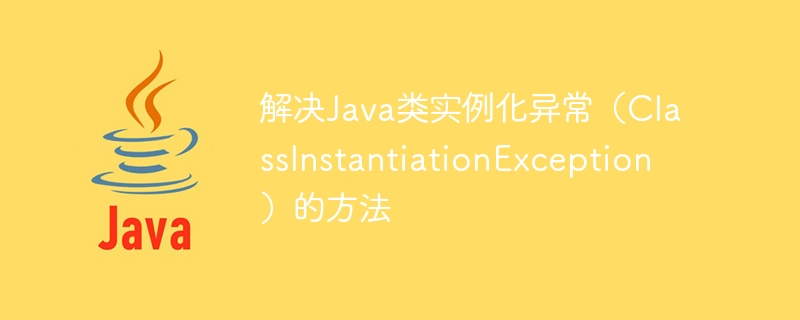 Java
Java
 javaTutorial
javaTutorial
 Methods to solve Java class instantiation exception (ClassInstantiationException)
Methods to solve Java class instantiation exception (ClassInstantiationException)
Methods to solve Java class instantiation exception (ClassInstantiationException)

Methods to solve Java class instantiation exceptions (ClassInstantiationException)
In Java programming, we often encounter class instantiation exceptions (ClassInstantiationException), that is, in A problem occurred while instantiating a class. This exception generally occurs in the following situations:
- The class does not have a parameterless constructor;
- The constructor of the class is private;
- Class is an abstract class;
- class is an interface;
- class is an array type.
In response to these situations, we can take some methods to solve class instantiation exceptions.
First of all, for classes that do not have a parameterless constructor, we can manually add a parameterless constructor. For example, suppose there is a class called Person with only one constructor with parameters. We can add a parameterless constructor to the class:
public class Person {
private String name;
private int age;
public Person(String name, int age) {
this.name = name;
this.age = age;
}
public Person() {
// 无参构造方法
}
}Next, for classes with private constructors, we can use reflection to instantiate an object of this class. Use reflection to bypass access restrictions and instantiate classes with private constructors. The following is a sample code that uses reflection to instantiate a private constructor class:
public class Test {
public static void main(String[] args) throws Exception {
Class<?> clazz = PrivateClass.class;
Constructor<?> constructor = clazz.getDeclaredConstructor();
constructor.setAccessible(true);
PrivateClass privateClass = (PrivateClass) constructor.newInstance();
}
}
class PrivateClass {
private PrivateClass() {
// 私有构造方法
}
}For abstract classes and interfaces, we cannot instantiate them directly, but we can instantiate them by creating an object of a concrete subclass or implementation class change. The following is a sample code for instantiating an abstract class using a concrete subclass:
abstract class AbstractClass {
// 抽象类
}
class SubClass extends AbstractClass {
// 具体子类
}
public class Test {
public static void main(String[] args) {
AbstractClass abstractClass = new SubClass();
}
}Finally, for array type classes, we only need to use the new keyword to instantiate. The following is a sample code for instantiating an array type class:
public class Test {
public static void main(String[] args) {
int[] array = new int[10];
}
}In summary, for Java class instantiation exceptions, we can bypass the access permissions of the private constructor by adding a parameterless constructor and using reflection , use concrete subclasses to instantiate abstract classes or interfaces, use new keywords to instantiate array type classes, etc. to solve the problem. However, it should be noted that in practice, appropriate solutions should be selected according to specific situations to ensure the correctness and maintainability of the code. I hope this article can provide you with some help in solving Java class instantiation exception problems.
The above is the detailed content of Methods to solve Java class instantiation exception (ClassInstantiationException). For more information, please follow other related articles on the PHP Chinese website!

Hot AI Tools

Undresser.AI Undress
AI-powered app for creating realistic nude photos

AI Clothes Remover
Online AI tool for removing clothes from photos.

Undress AI Tool
Undress images for free

Clothoff.io
AI clothes remover

AI Hentai Generator
Generate AI Hentai for free.

Hot Article

Hot Tools

Notepad++7.3.1
Easy-to-use and free code editor

SublimeText3 Chinese version
Chinese version, very easy to use

Zend Studio 13.0.1
Powerful PHP integrated development environment

Dreamweaver CS6
Visual web development tools

SublimeText3 Mac version
God-level code editing software (SublimeText3)

Hot Topics
 1378
1378
 52
52
 How does Java's classloading mechanism work, including different classloaders and their delegation models?
Mar 17, 2025 pm 05:35 PM
How does Java's classloading mechanism work, including different classloaders and their delegation models?
Mar 17, 2025 pm 05:35 PM
Java's classloading involves loading, linking, and initializing classes using a hierarchical system with Bootstrap, Extension, and Application classloaders. The parent delegation model ensures core classes are loaded first, affecting custom class loa
 How do I implement multi-level caching in Java applications using libraries like Caffeine or Guava Cache?
Mar 17, 2025 pm 05:44 PM
How do I implement multi-level caching in Java applications using libraries like Caffeine or Guava Cache?
Mar 17, 2025 pm 05:44 PM
The article discusses implementing multi-level caching in Java using Caffeine and Guava Cache to enhance application performance. It covers setup, integration, and performance benefits, along with configuration and eviction policy management best pra
 How can I use JPA (Java Persistence API) for object-relational mapping with advanced features like caching and lazy loading?
Mar 17, 2025 pm 05:43 PM
How can I use JPA (Java Persistence API) for object-relational mapping with advanced features like caching and lazy loading?
Mar 17, 2025 pm 05:43 PM
The article discusses using JPA for object-relational mapping with advanced features like caching and lazy loading. It covers setup, entity mapping, and best practices for optimizing performance while highlighting potential pitfalls.[159 characters]
 How do I use Maven or Gradle for advanced Java project management, build automation, and dependency resolution?
Mar 17, 2025 pm 05:46 PM
How do I use Maven or Gradle for advanced Java project management, build automation, and dependency resolution?
Mar 17, 2025 pm 05:46 PM
The article discusses using Maven and Gradle for Java project management, build automation, and dependency resolution, comparing their approaches and optimization strategies.
 How do I create and use custom Java libraries (JAR files) with proper versioning and dependency management?
Mar 17, 2025 pm 05:45 PM
How do I create and use custom Java libraries (JAR files) with proper versioning and dependency management?
Mar 17, 2025 pm 05:45 PM
The article discusses creating and using custom Java libraries (JAR files) with proper versioning and dependency management, using tools like Maven and Gradle.



